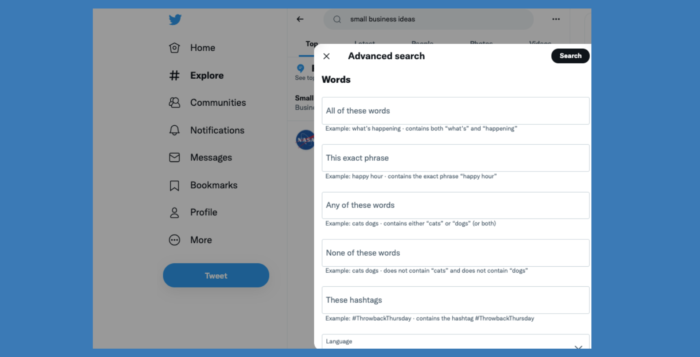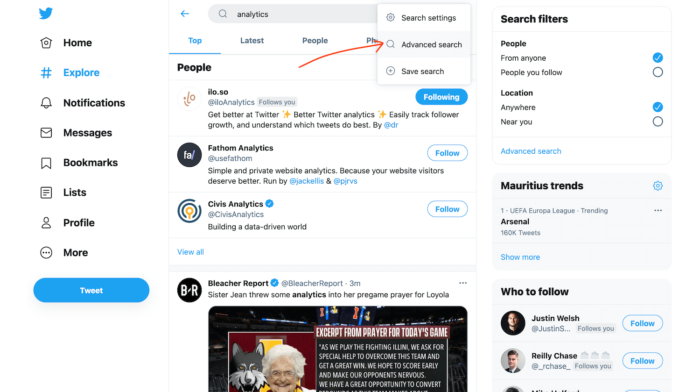Twitter stands as one of the most influential social media platforms globally, facilitating real-time communication, information dissemination, and networking. Founded in 2006, Twitter allows users to share short messages, or “tweets,” limited to 280 characters. This brevity encourages concise expression and makes tweets easy to consume.
Twitter’s user base spans various demographics, including individuals, businesses, celebrities, politicians, and news organizations. Its open nature fosters conversations on diverse topics, ranging from personal interests to global events. The platform’s features include retweets, likes, hashtags, and mentions, which enhance engagement and virality.
Table of Contents
Importance of Twitter Search in Social Discovery
Twitter Search serves as a powerful tool for social discovery, enabling users to find relevant content, conversations, and individuals. Its significance lies in several key aspects:
Real-Time Information
Twitter Search provides access to real-time updates on trending topics, breaking news, and ongoing discussions worldwide. Users can stay informed about current events and join conversations as they unfold.
Content Discovery
The search feature allows users to explore a vast repository of tweets, multimedia content, and user-generated discussions. By leveraging keywords, hashtags, and filters, individuals can discover content aligned with their interests and preferences.
Community Engagement
Twitter Search facilitates engagement with diverse communities and stakeholders. Users can connect with like-minded individuals, participate in conversations, and contribute to broader discussions on relevant topics.
Research and Analysis
Researchers, journalists, marketers, and analysts utilize Twitter Search to gather insights, monitor trends, and conduct sentiment analysis. The platform’s searchable archive enables retrospective analysis of past events and user interactions.
Brand Visibility and Reputation Management
Businesses and organizations leverage Twitter Search to monitor brand mentions, customer feedback, and industry discussions. By actively participating in relevant conversations and addressing customer concerns, brands can enhance their visibility and manage their online reputation effectively.
Similar read: What Is My Zip Code?
Twitter’s Basic Search Techniques

Keyword Search
Users can enter specific keywords or phrases into the search bar to find tweets containing those terms. Twitter’s search algorithm ranks results based on relevance, recency, and user engagement.
Hashtag Search:
Hashtags, denoted by the “#” symbol, categorize tweets by topic or theme. Users can search for hashtags to discover related discussions and content across the platform. Hashtag search results include tweets containing the specified hashtag.
User Search
Users can search for specific Twitter accounts by entering their usernames into the search bar. This allows individuals to explore tweets, media, and interactions associated with a particular user profile.
Advanced Search Filters for Precise Results
Date Range
Twitter’s advanced search feature enables users to specify a date range for search results. This functionality is useful for retrieving tweets posted within a particular timeframe, facilitating historical research and trend analysis.
Location
Twitter allows users to filter search results based on geographic location. By specifying a location or radius, users can discover tweets originating from or mentioning specific regions or places.
Sentiment Analysis
While Twitter’s native search interface does not provide explicit sentiment analysis, users can infer sentiment by analyzing the content of tweets, including language, tone, and context.
Additionally, third-party tools and analytics platforms offer sentiment analysis capabilities for Twitter data, categorizing tweets as positive, negative, or neutral based on their textual content.
These advanced search filters empower users to refine their search queries and obtain more precise results tailored to their information needs. By leveraging these techniques, individuals can navigate the vast volume of tweets on Twitter effectively and uncover relevant insights and conversations.
Similar read: What Is TBH Meaning On Instagram
Using Twitter Search for Personal Branding

Identifying Relevant Conversations in Your Niche
Twitter Search enables individuals to identify and participate in conversations relevant to their brand or niche. By searching for keywords, hashtags, and topics related to their expertise or interests, users can discover ongoing discussions and engage with relevant audiences.
Engaging with Influencers and Thought Leaders
Twitter Search facilitates the discovery of influencers and thought leaders within specific industries or fields. Users can search for key figures in their niche, follow their profiles, and engage with their content through likes, retweets, and replies. Building relationships with influencers can amplify personal branding efforts and expand one’s network.
Monitoring Brand Mentions and Feedback
Personal branding involves managing one’s online reputation and perception. Twitter Search allows individuals to monitor brand mentions, feedback, and conversations related to their brand. Users can respond to inquiries, address concerns, and cultivate a positive brand image by tracking mentions of their name, username, or relevant keywords.
Twitter Search for Content Discovery
Twitter Search serves as a valuable tool for discovering relevant content and staying informed on various topics of interest. Users can leverage Twitter’s search functionality to:
Explore Trending Topics
By searching for trending hashtags and topics, users can discover popular conversations and current events on Twitter. This helps individuals stay up-to-date with the latest trends and discussions in their industry or area of interest.
Find Curated Content
Twitter Search allows users to find curated content shared by influencers, thought leaders, and industry experts. By searching for relevant keywords and hashtags, individuals can discover articles, blog posts, videos, and other resources that align with their interests and expertise.
Identify Engaging Multimedia
Twitter Search enables users to find engaging multimedia content, including photos, videos, and GIFs, shared by other users. By searching for specific media types or keywords, individuals can discover visually compelling content to share with their followers and enhance their brand.
Similar read: ISTG Meaning In Text Messaging
Twitter Search for Market Research

Twitter Search serves as a powerful tool for market research, enabling businesses to analyze customer sentiment and feedback, identify emerging trends and consumer preferences, and conduct competitor analysis and benchmarking.
Analyzing Customer Sentiment and Feedback
Twitter Search provides a valuable platform for analyzing customer sentiment and feedback in real time. By searching for mentions of their brand, products, or services, businesses can gauge how customers perceive their offerings.
Analyzing the sentiment of tweets (positive, negative, or neutral) allows companies to identify areas for improvement, address customer concerns, and enhance overall customer satisfaction.
Identifying Emerging Trends and Consumer Preferences
Twitter Search enables businesses to identify emerging trends and consumer preferences by monitoring relevant hashtags, keywords, and conversations.
By analyzing the topics and discussions gaining traction on Twitter, companies can gain insights into evolving consumer interests, behaviors, and preferences. This information can inform product development, marketing strategies, and business decisions to better align with market demands.
Conducting Competitor Analysis and Benchmarking
Twitter Search allows businesses to conduct competitor analysis and benchmarking by monitoring the activities and conversations of competitors on the platform.
By searching for mentions of competitor brands, products, or key personnel, companies can gain insights into competitor strategies, market positioning, and customer perceptions.
This information can help businesses identify competitive strengths and weaknesses, refine their strategies, and differentiate their offerings in the marketplace.
Social Listening with Twitter Search
Monitoring Real-Time Conversations and Events
Twitter Search is a powerful tool for monitoring real-time conversations and events across the platform. By searching for relevant keywords, hashtags, and topics, individuals and businesses can stay informed about ongoing discussions, news, and events in their industry or area of interest.
Monitoring real-time conversations enables proactive engagement, timely responses to customer inquiries or concerns, and the opportunity to capitalize on trending topics and opportunities.
Tracking Industry News and Updates
Twitter Search facilitates the tracking of industry news and updates by enabling users to search for relevant hashtags, keywords, and accounts. By following industry-specific hashtags and thought leaders, individuals and businesses can stay abreast of the latest developments, trends, and insights in their field.
Tracking industry news and updates on Twitter helps inform strategic decision-making, identify emerging opportunities, and maintain a competitive edge in the marketplace.
Participating in Twitter Chats and Trending Discussions:
Twitter Search empowers users to discover and participate in Twitter chats and trending discussions related to their interests, industry, or niche. By searching for relevant hashtags and topics, individuals can find ongoing Twitter chats, participate in discussions, and engage with like-minded peers and influencers.
Participating in Twitter chats and trending discussions enables networking, knowledge sharing, and community building, while also increasing visibility and thought leadership within a particular domain.
Integrating Twitter Search into Marketing Campaigns
Incorporating User-Generated Content (UGC)
Twitter Search can be integrated into marketing campaigns by leveraging user-generated content (UGC). Brands can search for mentions, hashtags, and keywords related to their products or campaigns to discover user-generated content created by their audience.
By curating and sharing UGC, brands can foster community engagement, build trust, and amplify their marketing message through authentic user experiences.
Amplifying Reach through Viral Trends and Challenges
Twitter Search enables marketers to identify viral trends and challenges that resonate with their target audience. By monitoring trending hashtags, topics, and discussions, brands can identify opportunities to participate in relevant conversations and amplify their reach.
By creating content that aligns with viral trends and challenges, brands can increase visibility, drive engagement, and connect with a broader audience on Twitter.
Measuring Performance Metrics and ROI
Twitter Search can be used to measure performance metrics and return on investment (ROI) for marketing campaigns. Marketers can track key performance indicators (KPIs) such as impressions, engagements, click-through rates, and conversions by analyzing search results, mentions, and interactions related to their campaigns.
By monitoring performance metrics, marketers can evaluate the effectiveness of their campaigns, optimize strategies in real-time, and demonstrate the impact of their marketing efforts on business objectives.
Incorporating Twitter Search into marketing campaigns enables brands to harness real-time insights, leverage user-generated content, capitalize on viral trends, and measure campaign performance effectively. By integrating Twitter Search into their marketing strategies, brands can engage with their audience, drive meaningful interactions, and achieve their marketing goals on the platform.
Optimizing Twitter Search for Business Growth
Building a Targeted Audience and Community
Utilize Twitter Search to identify and connect with a targeted audience by searching for relevant keywords, hashtags, and conversations in your industry or niche. Engage with users who are actively discussing topics related to your business, follow relevant accounts, and participate in relevant Twitter chats and discussions to build a community around your brand.
By nurturing relationships and providing value to your audience, you can cultivate a loyal following and expand your reach on Twitter.
Driving Website Traffic and Lead Generation:
Leverage Twitter Search to drive website traffic and generate leads by sharing compelling content and calls-to-action (CTAs) with your audience. Monitor conversations and trending topics related to your products or services, and share relevant links to your website or landing pages.
Encourage users to visit your website by offering valuable resources, exclusive offers, or incentives. By tracking referral traffic and conversions from Twitter, you can measure the effectiveness of your lead-generation efforts and optimize your strategy accordingly.
Increasing Brand Visibility and Authority:
Increase brand visibility and authority on Twitter by consistently sharing valuable content, engaging with your audience, and participating in industry discussions. Use Twitter Search to identify opportunities to contribute to relevant conversations, share insights and expertise, and establish your brand as a trusted authority in your field.
Amplify your reach by leveraging trending topics, hashtags, and viral trends to showcase your brand’s unique perspective and personality. By consistently adding value to the Twitter community, you can strengthen your brand’s visibility, credibility, and influence over time.
Tips for Effective Twitter Search Management
Establishing Clear Objectives and Goals
Before diving into Twitter search management, it’s crucial to establish clear objectives and goals for your search efforts. Determine what you aim to achieve through Twitter search, whether it’s monitoring brand mentions, tracking industry trends, engaging with your audience, or conducting market research.
By defining your objectives and goals upfront, you can tailor your search strategy to align with your business priorities and measure success effectively.
Setting Up Routine Monitoring and Analysis
Consistent monitoring and analysis are essential for effective Twitter search management. Set up routine monitoring schedules to track relevant keywords, hashtags, and conversations in real time. Use Twitter’s advanced search filters to narrow down search results and focus on the most relevant content.
Regularly analyze search data to identify emerging trends, monitor sentiment, and measure the impact of your efforts. By staying proactive and responsive, you can leverage Twitter search to stay informed, engage with your audience, and drive actionable insights for your business.
Staying Updated on Platform Changes and Features
Twitter is constantly evolving, with new features, algorithms, and changes to its platform. Stay updated on platform changes and features related to Twitter search to maximize its effectiveness for your business.
Follow Twitter’s official announcements, blogs, and documentation to learn about new search functionalities, updates to search algorithms, and best practices for optimizing search performance.
By staying informed and adapting to changes in the Twitter landscape, you can stay ahead of the curve and leverage Twitter search to its full potential for your business objectives.
- What is Epic Games Launcher and How to Install It? - July 15, 2024
- What Is Audius Music Streaming App and How Does it Work? - July 13, 2024
- The 10 Best Astronomy Apps for Stargazing - July 12, 2024

